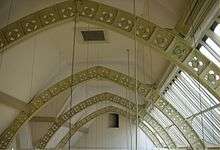Martin & Chamberlain

John Henry Chamberlain, William Martin, and Frederick Martin were architects in Victorian Birmingham, England. Their names are attributed singly or pairs to many red brick and terracotta buildings, particularly 41 of the forty-odd Birmingham board schools made necessary by the Elementary Education Act 1870.
- John Henry Chamberlain (1831–1883)
- Settled in Birmingham in 1856 and went into partnership with William Martin in 1864. He was the innovative designer in the partnership. The grade I listed Birmingham School of Art, Margaret Street was one of his last commissions. It was finished by William Martin after Chamberlain's death.
- William Martin (1829–1900)
- Was the Birmingham public works architect when J. H. Chamberlain joined him. He continued to work under the name of Martin & Chamberlain after Chamberlain's death. He later went into partnership with his son, Frederick Martin.
- Frederick Martin
- Son of William Martin, designed the grade I listed former Bell Edison Telephone Building: 17 & 19 Newhall Street.
Martin & Chamberlain were responsible for the Birmingham board schools, being made architects to the new Schools Board in 1871 and building 30 schools between 1871 and 1883, using Chamberlain's gothic design and bold visible ironwork. They were the surveyors for the new Corporation Street from 1878.
They designed police stations, public baths and waterworks.
In 1871 Martin & Chamberlain were responsible for St Nicolas' Church, Hockley, St Stephen's Church, Selly Park, St Barnabas church in the Franche area of Kidderminster.[1] St John's Church, Sparkhill, built in 1888, and St. Cyprian's Church, Hay Mills are further examples of their work.
See also
| Wikimedia Commons has media related to Martin & Chamberlain. |
References
- The Victorian Society in Birmingham (Three City Trails, Victorian Architects of Birmingham)
- Pevsner Architectural Guides - Birmingham, Andy Foster, 2005, ISBN 0-300-10731-5
- Victorian Architecture, Roger Dixon & Stefan Muthesius, 1978
Notes
- ↑ Pevsner, Nikolaus The Buildings of England: Worcestershire 1968 p156